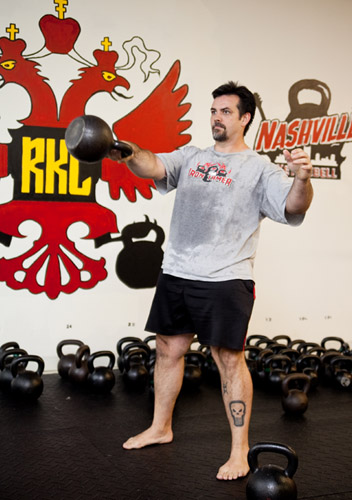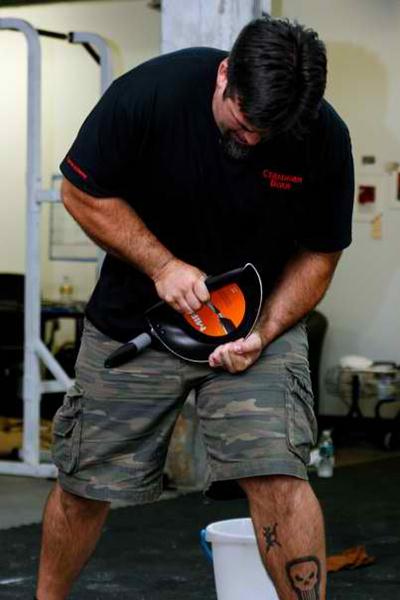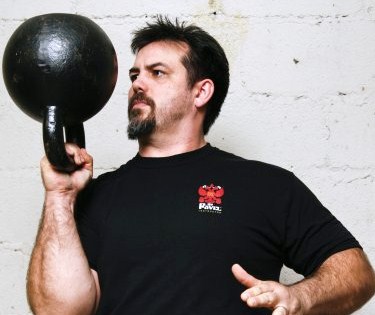How did you originally find kettlebell training?
David Whitley: In 2002, I was a massage therapist and trained "normally" in a gym. One of my clients bought a
16kg kettlebell and asked if I knew anything about it. Around the same time I read an article that Pavel wrote in Muscle Media. Next to the article was a full-page ad for the original RKC book and
Dragon Door kettlebells. I didn't know much about them but I had seen kettlebells in pictures with old-time strongmen and had read Pavel's
Relax Into Stretch and
Power to the People!
I borrowed the 16kg kettlebell and the original Russian Kettlebell Challenge VHS—within half an hour, figured I knew enough to try snatching. What’s the worst thing that could happen? I have a vivid memory of snatching that 16kg kettlebell poorly for 10 reps on the right, then switching in midair before doing 10 reps on the left. I thought I had really accomplished something, then about ten seconds later, I had to sit down. Either the kettlebell was removing oxygen molecules from the air, or there was really something to this kind of training, and I needed to pay attention to it. Of course, it's the training, so I bought the
Russian Kettlebell Challenge book.
Enter the Kettlebell wasn't even published yet! In 2003, I went to Minneapolis for an
RKC Workshop. By the end of the weekend, I knew that the RKC would be very important in my life.
Dragon Door: Recently you've been on a quest for strength, using breathing and mental techniques. What are you doing?
David Whitley: In 1995, my martial arts teacher introduced me to Qigong, breathing, cultivating internal energy and power. I practiced a Southern Praying Mantis Kung Fu style with a strong internal and external component. Breathing exercises and Qigong accompanied our physical practice. I spent a fair amount of time working on Qigong and meditation for several years in the '90s, then drifted away to study other things. After the RKC, I started to read some of
John Du Cane's Qigong books.
I am also involved in old-time strongman feats of strength—bending steel, tearing phonebooks, tearing decks of cards, rolling up frying pans, and sledgehammer levering. A few years ago I met Dennis Rogers, who is probably the most-seen performing strongman in history. He took me on as a student and introduced me to his mentor, Slim the Hammer Man. I read a book about Slim's mentor, Joseph Greenstein, "The Mighty Atom." Slim and the Atom are both legendary performing strongmen.
The Atom’s biography is a very interesting, entertaining read on the surface, but there's also a lot of hidden information in it. After re-reading that book for the 20th time last year, it all came together. Greenstein writes that strength transcends the physical—it's a mental or spiritual endeavor.
We've all heard stories and factual records of untrained people doing impossible things like lifting a car off of a child. The common element is a state of emergency where there's no choice. At one point, "The Mighty Atom" was shot in the forehead, but the bullet didn't penetrate his skull. He realized that all of his training, exercise, and breathing practice had prepared his body in a way that went far beyond the physical.
"The Mighty Atom" was Jewish and studied the Kabbala, but he found parallels in other traditions. Asian martial arts seek to develop chi—or "ki" (Japanese term). Traditional yogic practices seek to combine the body, breath, mind, and spirit in a process of enlightenment. Indian traditions also mention Kundalini energy, not to be confused with Kundalini Yoga (something different.) Kundalini is about awakening latent energy, what Buddhists and Hindus refer to as spiritual awakening or "enlightenment."
Through studying old-time strongmen and talking with my martial arts friends who've achieved Kundalini awakening, I realized it's simply a biological process. If I do A, B, and C, the result is D. Behind the mysticism, ritual, and weirdness are scientific elements. Doing particular exercises will eventually bring results, just like strength training.
Dragon Door: I talked to Bud Jeffries recently. He mentioned an old-time strongman phrase, vital energy, to describe a similar idea. What happened when you practiced the exercises?
David Whitley: The martial art called is called Hoshin Budo and the specific breathing and energy developing practices are called Hoshin Tao Chi Kung. Doctor Glenn Morris developed the Hoshin system based on a collection of martial arts practices, including a large component of traditional Bujinkan Ninjutsu. He died six years ago, so I never got a chance to meet him, but we e-mailed a few times. Rob Williams, the current soke (head of the school), put me in touch with James Alexander. James is a ninth degree black belt in Hoshin Budo who's experienced a full Kundalini awakening and wants to learn feats of strength. Chi development diminishes over time if you stop practicing, but a full Kundalini awakening never stops. It's there all the time—the old traditions considered it enlightenment.
I was taught to perform feats of strength by mentally going to a place where the task at hand is the only thing which exists. This is a powerful replica of a life-and-death situation. Experiencing this voluntarily, willingly, and repeatedly will grant access to the power. To my understanding and belief, this is very much the same as chi development, Kundalini, life force, or universal energy. It sounds esoteric and strange unless you have the ears to hear it.
James told me I had gotten myself ready by practicing feats of strength which push my body and brain up against a limit over and over again. James taught me specific exercises to fill in the gaps. An analogy would be having a garage full of parts and learning I could put together a fully functioning helicopter with the correct blueprint. I started practicing the exercises, and experienced the full Kundalini awakening. I kept detailed notes of everything that I did leading up to the Kundalini and have been sifting through them in an effort to make it repeatable. I haven't talked about it much because it happened very recently. I know I'll get weird reactions, which is fine, but I also don't want to alienate anybody.
Dragon Door: How were you training before the experience, and how has it affected your training?
David Whitley: After the first
Purposeful Primitive workshop with Marty Gallagher and Kirk Karwoski, my primary focus has been powerlifting. I learned to squat again after surgery for bone spurs in my right knee in January 2011. Before surgery, I couldn't completely extend or flex my right knee or squat without pain. Deadlifts and swings weren't an option—I couldn't extend my right knee, so my left hip was hyperextending, making my left SI joint constantly hurt. Using full tension and abdominal bracing even made pull ups hurt the SI joint. All I could do was bend steel, work on grip feats and sledgehammer levering.
Since February of last year, I've dropped close to 60 pounds, because I could finally move without pain. I'm not one to make excuses. I like to eat, and I'm an emotional eater—I'll admit it. There's a 13-year-old cheerleader inside me that wants cookies when she's depressed, but the part of me that likes to squat is much stronger.
I went through the Kundalini experience this past February. Literally, the next day I was physically able to do things I couldn't do the day before. I could bend pieces of steel which I wasn't quite able to before, I could squat and deadlift heavier weights. It still took a lot of effort of course.
Before the experience, I had been experimenting with a heart rate monitor and an idea from Geoff Neupert. I would swing, but stop before the swing speed going up (concentric) slowed down. Next, I'd check the heart rate monitor, and wait for my heart rate to drop back to a predetermined number before starting my next set. I could do more total swings than if I did regular timed sets or a target rep/set range. Instead of letting the clock guide my session, I let my rep speed dictate when to stop and let my heart rate dictate when to start again.


I trained with the heart rate monitor several months before I started practicing Qigong again. When I talked to James and started practicing Hoshin Tao Qigong, everything related back to a similar "fight or flight" situation where the mind is clear of everything except the task at hand. Through my swing practice, it was easy to get into that state by attaining and keeping my heart rate in the maximal range. The longer I could stay there calmly and comfortably, the more I improved. I'm not recommending that anyone my age try this—it's purely self-experimentation and I've been doing swings for nearly 10 years. For the rest periods between sets, I used controlled-breathing techniques to calm my mind and quickly lower my heart rate. Now, I'm able to drop my heart rate from the mid-160s to the mid-140s inside of a minute, even though that wasn't an objective.
I feel like I've gained control over my breathing, similar to the idea from "The Mighty Atom" biography. The Mighty Atom's teacher, Volanko said, "If you learn to control the breath, you can control the bodily functions." This is the same universal idea with yoga, Qigong, and traditions which cultivate life force. I applied it to Hardstyle methodology. Four to six days a week of this training allowed me to elicit a particular physiological "fight or flight" response so I could practice specific breathing techniques.
Historically, many people who have achieved the Kundalini have been martial artists, rather than peaceful people like monks or priests. For instance, a few hundred years ago, martial artists and samurais in feudal Japan were in life and death situations fairly often. A life and death mentality was part of the culture, and in every warrior tradition. Using kettlebells, bending steel, and heavy lifting as part of a meditative process, accelerated my ability to awaken the Kundalini beyond my expectations.
The external takeaway is to watch for rep speed and heart rate when performing kettlebell swings. This will yield better quality swings, more swings, and potentially dramatic fat loss. That's the big sell for the general public, who probably don't want to wake up their Kundalini.
Dragon Door: This is really fascinating! When I started learning about kettlebells, I kept finding myself in a Tai Chi/Qigong mind space.
David Whitley: That mental state is what the Japanese call mushin, meaning "no mind." It's a meditative state of being completely aware and unaffected at the same time. I experienced it multiple times over the past several years when pushing swings or snatches to a point where I was only aware of the task at hand.
An explosive, almost violent physical activity like kettlebell swings can seem chaotic, yet at the center is a very still spot. From that vantage point, everything can be seen, if the mind can be still. I can be part of it and experience the full power of it without being attached to any one part. I think it's our natural state as humans, we're just constantly distracted from it. Concentration doesn't mean to try harder, it means fixing the attention in one spot.
This is the first time that I've talked to anybody in an interview or public setting about my experience. I haven't blogged, "I went through the Kundalini." I don't know if I will, but I definitely want everyone who has the ears to hear about it.
Dragon Door: I really appreciate you sharing this intensely personal experience.
David Whitley: You are very welcome Adrienne!
 |
David Whitley is featured in the upcoming movie, Kraftakt, a German documentary about strongmen.
|